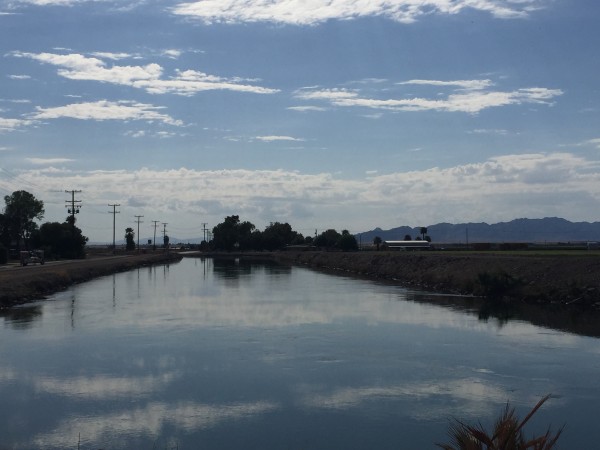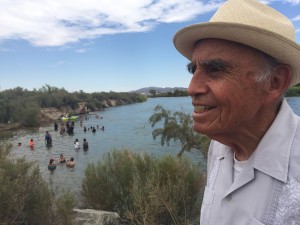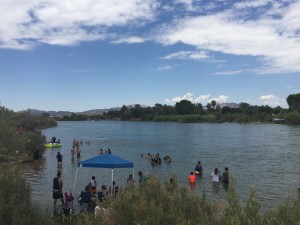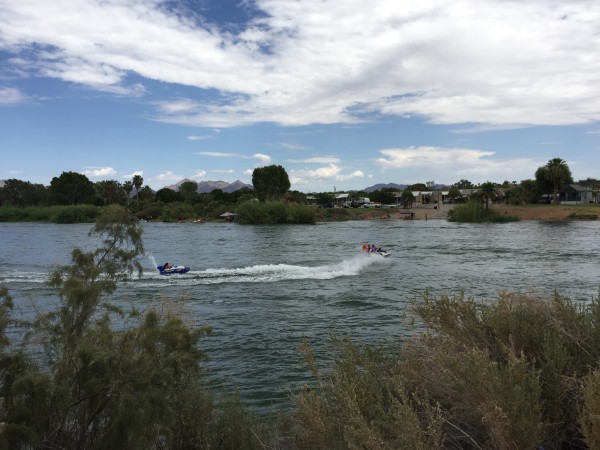Decades before the Standing Rock struggle to protect the Missouri River from oil contamination, the Chemehuevi Tribe launched a lesser known battle to protect the Colorado River from toxic waste dumping. At the helm of that epic battle was the veteran local activist Alfredo Figueroa. Recalling his struggles to combat toxic waste, Figueroa says that his passion to protect the river is linked to his roots as a community activist and his mission as a guardian of the sacred sites of the first peoples of the Colorado River Basin. Our reporter, Valeria Fernández, spoke with Figueroa, and today we present this report for National Native American Heritage Month.
… music…
It’s Sunday afternoon and dozens of families escape the heat wading into the dark blue green waters of the Colorado River. Shaded by his straw hat, Alfredo Acosta Figueroa admires the river with his wife Demesia. He is surprised by a swarm of his grandchildren.
“Ay, Chihuahua”
This is the same river where before grew up and raised nine children in Blythe, California. Now at 83 he sees it differently.
“It’s a way different river. The river right now for you to try to swim in the river, for you to try to drink water from the river you’re going to get sick, because the water has been highly contaminated. There’s no water that’s pure not more.”
There’s a certain sadness in those words. Figueroa was raised within the Chemehuevi culture. He is a water protector and a steward of native sacred sites along the Colorado River.
“Sometimes you feel you are not making any inroads…but you are. The struggle more people have to become aware.”
But Figueroa has. He carries the wisdom and the wounds of a lifelong struggle that extends from the picket lines for farm worker’s rights to the movement for civil rights and environmental justice.
“We were the first group in the history of the United States to stop a toxic waste dump from being built.”
It was 1992 and California Governor Pete Wilson was fully behind the effort to build a nuclear toxic dump in the public lands of Ward Valley.
“They were going to throw all these toxics from the nuclear power plant, throw them in the desert, 80 miles north from Blythe, in between Blythe and Needles, California.
“The toxics gradually go down to the river, cause they go down to the aquifers and the aquifers are directly tied to the River. That’s how the river gets a lot of water because of the aquifers.”
After eight years, the coalition of environmentalist groups and Native American nations was able to stop the plans for a nuclear dump in their ancestral lands. One key development was getting the support from the Mexican government. Mexico invoked bilateral treaties, which require the U.S. to let the Colorado water flow into Mexico and ensure water quality.
“They thought that here there would be no resistance, they underestimated. Like when people do their assumption, they say we can do this, but they have not done their footwork”.
Figueroa hears echoes of those battles in the ongoing resistance of the “water protectors,” the Standing Rock Sioux tribe activists who are fighting against an oil pipeline in an effort to protect the Missouri River and their sacred sites in North and South Dakota.
Figueroa says his experience as part of the farm worker’s movement with Cesar Chavez in the 1960s lead him in a natural way to environmental activism.
“We were already organized in that way of thinking. So and then, Cesar Chavez was 100 per cent, that’s why we used to use the office of the farm workers as the office to stop the Sun desert power plant and also to stop Ward Valley.”
Organizing runs in Figueroa’s family. His great-great grandmother Teodosa Murrieta came to the region in 1862 during the gold fever. His father was a self-employed miner who felt contempt for big companies and bosses. Figueroa followed in the tradition of that rebellious spirit. When Figueroa was little, Blythe was called the Little Mississippi due to discrimination and Spanish was banned in schools, Figueroa got kicked out of class for singing the Ballad of Joaquin Murrieta. A bandit for some, Murrieta was in the Mexican lore a Robin Hood that fought against White Americans and for the indigenous peoples.
Corrido de Joaquín Murrieta … Fade in under narration…
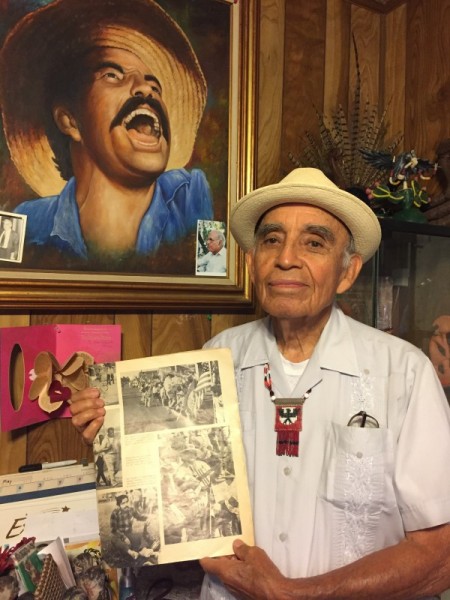
Alfredo Acosta Figueroa holds an edition of Times Magazine where his picture was published singing in support of the peasants with César Chávez and also inspired the portrait that appears behind him in this photo.
Figueroa takes his job as a sacred sites protector very seriously. He believes these fertile lands in the Colorado basin are the ancestral homeland of the Aztecs, the cradle of the great Mesoamerican civilization. A history, he said, that Spaniards tried to hide.
“At the mountain that’s called Big Maria mountain now, they changed the name to Coatepetl and they put Big Maria because that’s the mother of Jesus Christ.”
Whether Blythe is the cradle of Aztlan or not, the footprints of indigenous cultures are there. In order to protect them, Figueroa created La Cuna de Aztlán Sacred Sites Protection Circle. The group has an agreement with the federal Bureau of Land Management to preserve over 300 geoglyphs, those are large stone artworks created on the surface of the landscape.
“The mayority of people don’t know what petroglyphs are…We told them what they are because we have that knowledge, not because we picked it up in UCLA, no, that was brought down to us through our ancestors. Through our elders. We’ve been very concerned for a while now to protect them, specially now that they use the word green and they want to put solar power in the pristine desert”.
Figueroa’s latest battle, ironically, hasn’t been against toxic waste companies, but against clean-energy companies that plan to build thousands of acres of solar panels on top of sacred sites and destroying the trails that lead to them.
“Those main trails are very important because gradually if you destroy the trail you destroy that connection, cause the whole world is connected, we are all connected”.
That connection leads back to the river for Figueroa. A great river that for thousands of years was the lifeblood for a number of peoples along the 1,500 mile basin; it is now interrupted by dams, contaminated by pesticides and city waste.
As families enjoy refreshments on the river banks and power boats make waves in the shore, Figueroa says he would like to see more people get involved.
“I would like to see more people get involved…you see all this trash over here. Just by throwing out trash they are contributing to the contamination of the area. So it requires a lot of education and a lot more people need to be involved, instead of just continuing to do the same thing they’ve done all the time”.
Figueroa says change is in the hands of a new generation.
“Among all we do all, for the benefit of the whole, different sizes different shapes but together the trunk of the human race”.
For Radio Bilingue, Valeria Fernández, Blythe, California.
Photo: Valeria Fernández.
This story was produced in partnership with the Southwest Folklife Alliance from Tucson in collaboration with the Alliance for California Traditional Arts.
To watch the video of Don Alfredo Figueroa



